A Low-Profile Wideband Linear-to-Circular Polarization Conversion Slot Antenna Using Metasurface
Abstract
:1. Introduction
2. Design and Analysis of the Proposed Antenna
2.1. Design of the Metasurface Antenna
2.2. Mechanism of Circular Polarization
3. Parametric Analysis
4. Measured Results Analysis
5. Conclusions
Author Contributions
Funding
Conflicts of Interest
References
- Ameen, M.; Ahmad, O.; Chaudhary, R.K. Wideband circularly-polarised high-gain diversity antenna loaded with metasurface reflector for small satellite applications. Electron. Lett. 2019, 55, 829–831. [Google Scholar] [CrossRef]
- Ma, X.L.; Feng, Q.Y. Compact Circularly Polarized Antenna with Meta-surface. Radio Eng. 2017, 47, 44–47. [Google Scholar]
- Zarrabi, F.B.; Pirooj, A.; Pedram, K. Metamaterial loads used in microstrip antenna for circular polarization: Review. Int. J. RF Microw. Comput. Aided Eng. 2019, 29, e21869. [Google Scholar] [CrossRef]
- Ta, S.X.; Park, I. Low-Profile Broadband Circularly Polarized Patch Antenna Using Metasurface. IEEE Trans. Antennas Propag. 2015, 63, 5929–5934. [Google Scholar] [CrossRef]
- Xie, K.; Gao, J.; Cao, X.Y.; Gao, K.L. Design of a Wideband Low-profile Circularly Polarized Antenna Based on metasurface. Modern Radar 2016, 38, 59–63. [Google Scholar]
- Huang, Y.J.; Yang, L.; Li, J.; Wang, Y.; Wen, G.J. Polarization conversion of metasurface for the application of wide band low-profile circular polarization slot antenna. Appl. Phys. Lett. 2016, 109, 054101. [Google Scholar] [CrossRef]
- Juan, Y.; Yang, W.C.; Che, W.Q. Miniaturized Low-Profile Circularly Polarized Metasurface Antenna Using Capacitive Loading. IEEE Trans. Antennas Propag. 2019, 67, 3527–3532. [Google Scholar] [CrossRef]
- Sali, N.M.; Paul, B. A 2.4 GHz Polarization Reconfigurable Metasurface Antenna. In Proceedings of the 2015 Fifth International Conference on Advances in Computing and Communications (ICACC), Chennai, India, 25–26 July 2015; IEEE: Chennai, India, 2015. [Google Scholar]
- Akgol, O.; Altintas, O.; Unal, E.; Karaaslan, M.; Karadag, F. Linear to left- and right-hand circular polarization conversion by using a metasurface structure. Int. J. Microw. Wirel. Technol. 2017, 10, 133–138. [Google Scholar] [CrossRef]
- Rajanna, P.K.T.; Rudramuni, K.; Kandasamy, K. A High-Gain Circularly Polarized Antenna Using Zero-Index Metamaterial. IEEE Antennas Wirel. Propag. Lett. 2019, 18, 1129–1133. [Google Scholar] [CrossRef]
- Dehnavi, M.S.; Razavi, S.M.J.; Armaki, S.H.M. Improvement of the gain and the axial ratio of a circular polarization microstrip antenna by using a metamaterial superstrate. Microw. Opt. Technol. Lett. 2019, 61, 2261–2267. [Google Scholar] [CrossRef]
- Yue, T.W.; Jiang, Z.H.; Werner, D.H. Compact, Wideband Antennas Enabled by Interdigitated Capacitor-Loaded metasurfaces. IEEE Trans. Antennas Propag. 2016, 64, 1595–1606. [Google Scholar] [CrossRef]
- Zhu, H.L.; Cheung, S.W.; Liu, X.H.; Yuk, T.I. Design of Polarization Reconfigurable Antenna Using metasurface. IEEE Trans. Antennas Propag. 2014, 62, 2891–2898. [Google Scholar] [CrossRef]
- Wu, Z.; Li, L.; Li, Y.; Chen, X. Metasurface Superstrate Antenna with Wideband Circular Polarization for Satellite Communication Application. IEEE Antennas Wirel. Propag. Lett. 2016, 15, 374–377. [Google Scholar] [CrossRef]
- Zheng, Q.; Guo, C.J.; Ding, J. Wideband and low RCS circularly polarized slot antenna based on polarization conversion of metasurface for satellite communication application. Microw. Opt. Technol. Lett. 2018, 60, 679–685. [Google Scholar] [CrossRef]
- Nasimuddin; Qing, X.M.; Chen, Z.N. Broadband Circularly Polarized Antenna Using metasurface. In Proceedings of the Progress In Electromagnetics Research Symposium—Fall (PIERS—FALL), Singapore, 19–22 November 2017; IEEE: Singapore, 2017. [Google Scholar]
- Pan, Y.M.; Hu, P.F.; Zhang, X.Y.; Zheng, S.Y. A Low-Profile High-Gain and Wideband Filtering Antenna With metasurface. IEEE Trans. Antennas Propag. 2016, 64, 2010–2016. [Google Scholar] [CrossRef]
- Zarbakhsh, S.; Akbari, M.; Samadi, F.; Sebak, A.R. Broadband and High-Gain Circularly-Polarized Antenna with Low RCS. IEEE Trans. Antennas Propag. 2019, 67, 16–23. [Google Scholar] [CrossRef]
- Li, T.J.; Liang, J.G.; Li, H.P.; Niu, X.B.; Liu, Y.Q. Broadband circularly polarized high-gain antenna design based on linear-to-circular polarization conversion focusing metasurface. Acta Phys. Sin. 2017, 66, 064102. [Google Scholar]
- Sharma, A.; Gangwar, D.; Kanaujia, B.K.; Dwari, S. RCS reduction and gain enhancement of SRR inspired circularly polarized slot antenna using metasurface. AEU-Int. J. Electron. Commun. 2018, 91, 132–142. [Google Scholar] [CrossRef]
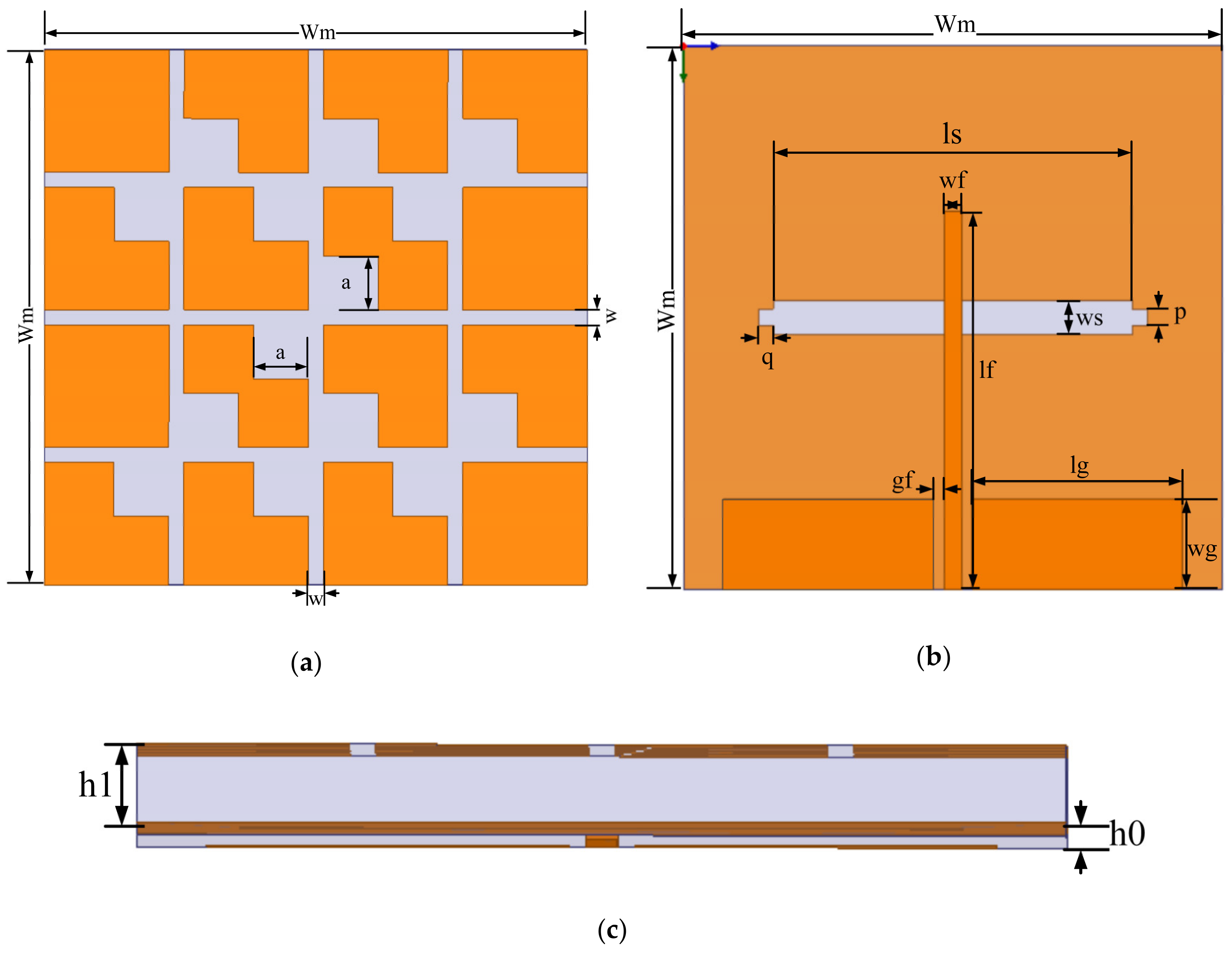



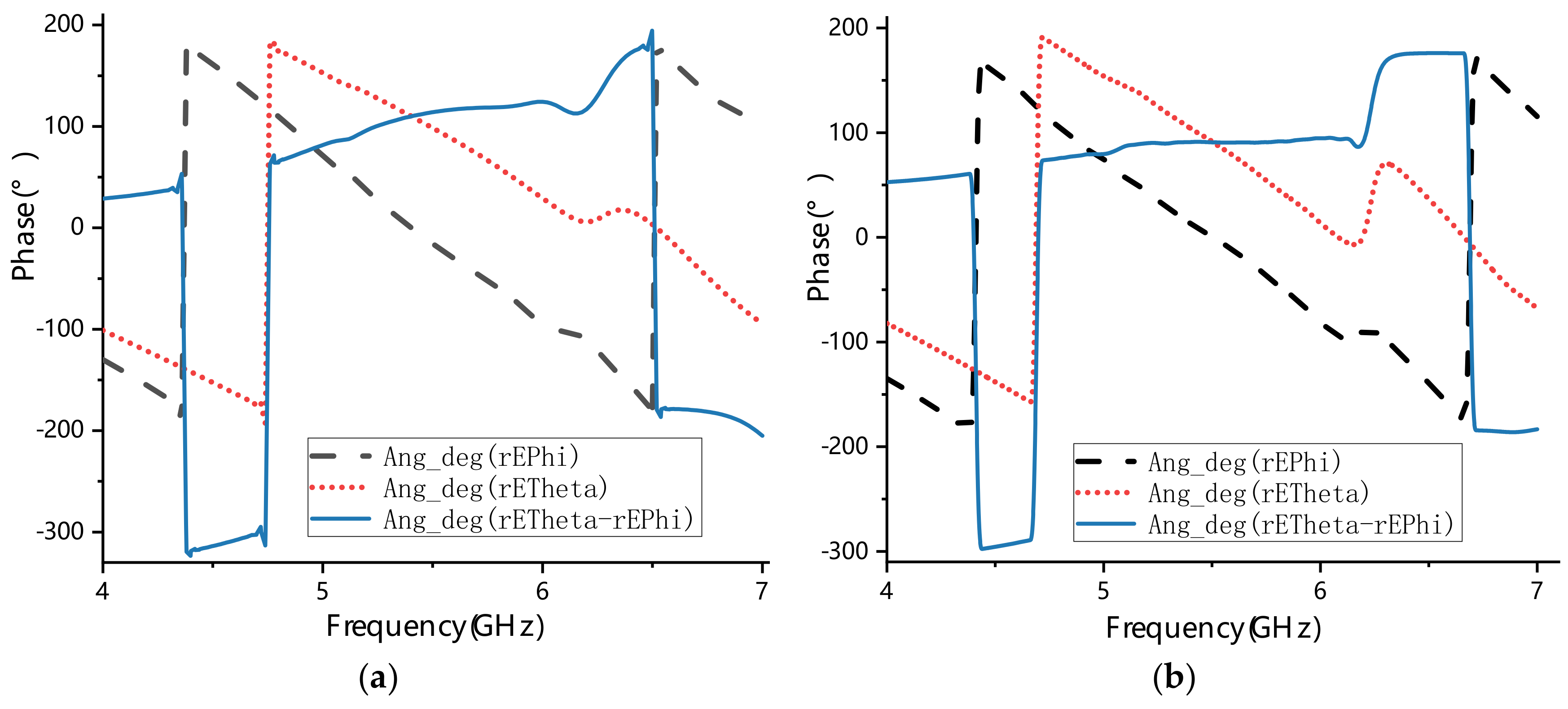
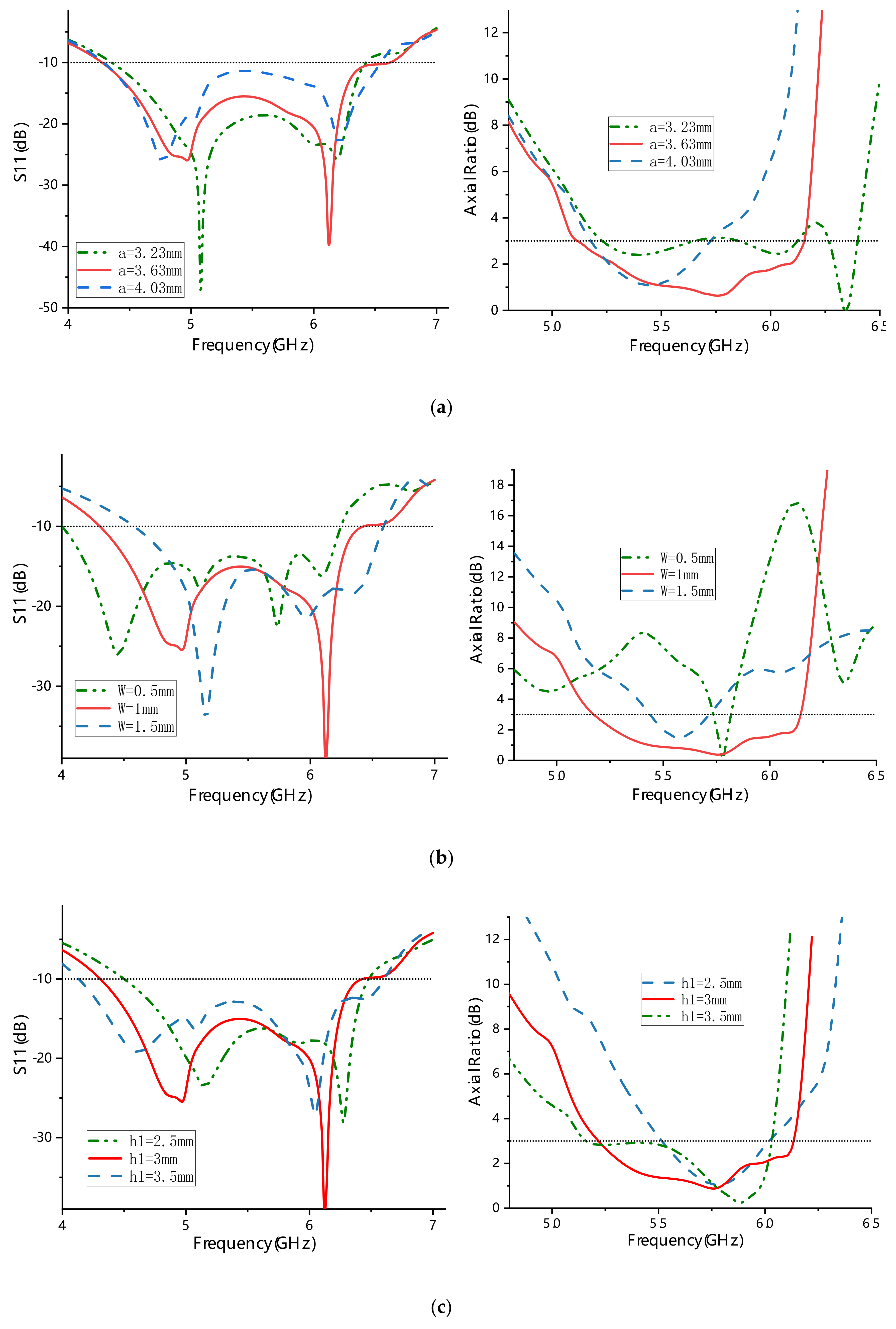
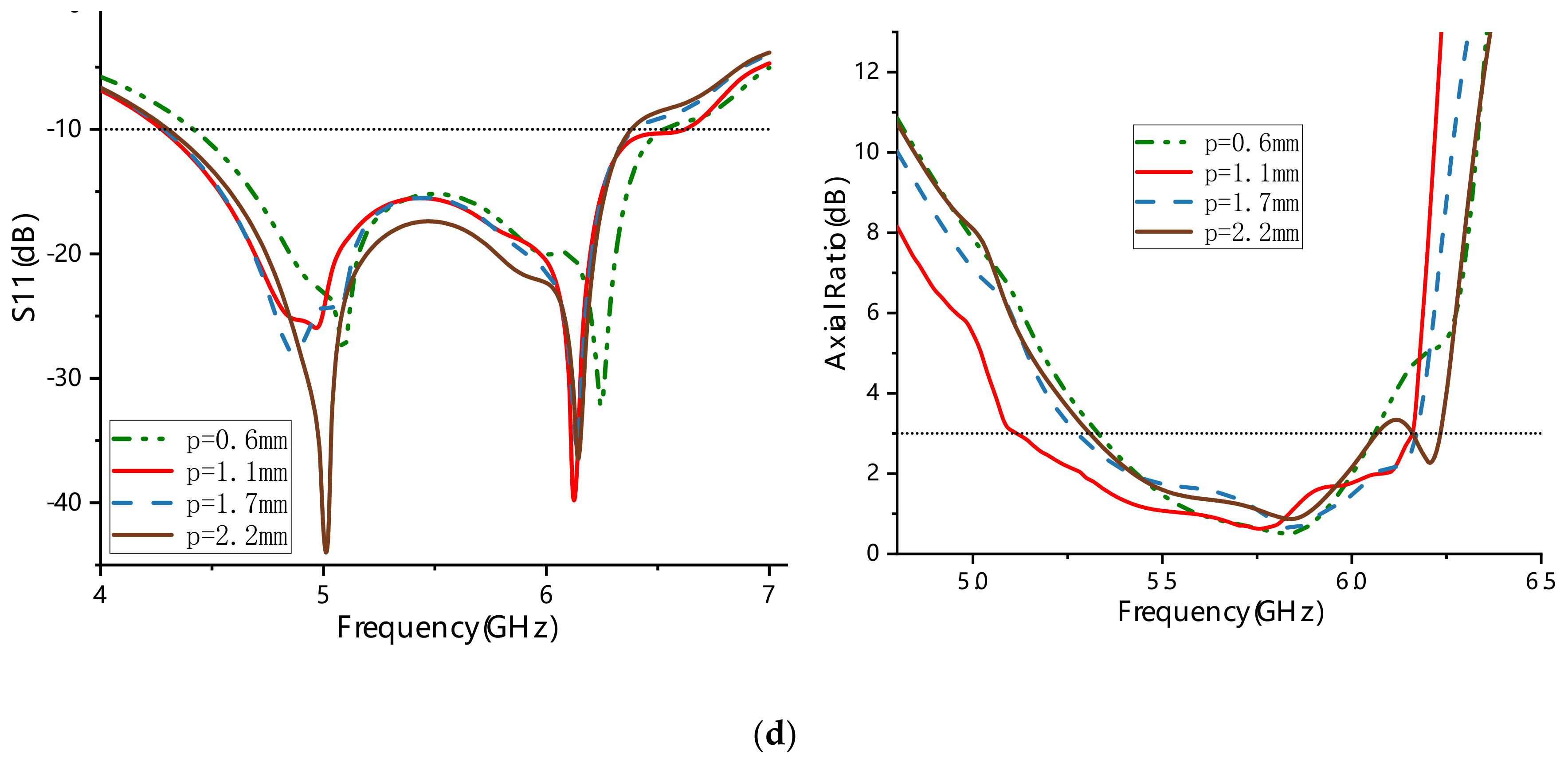
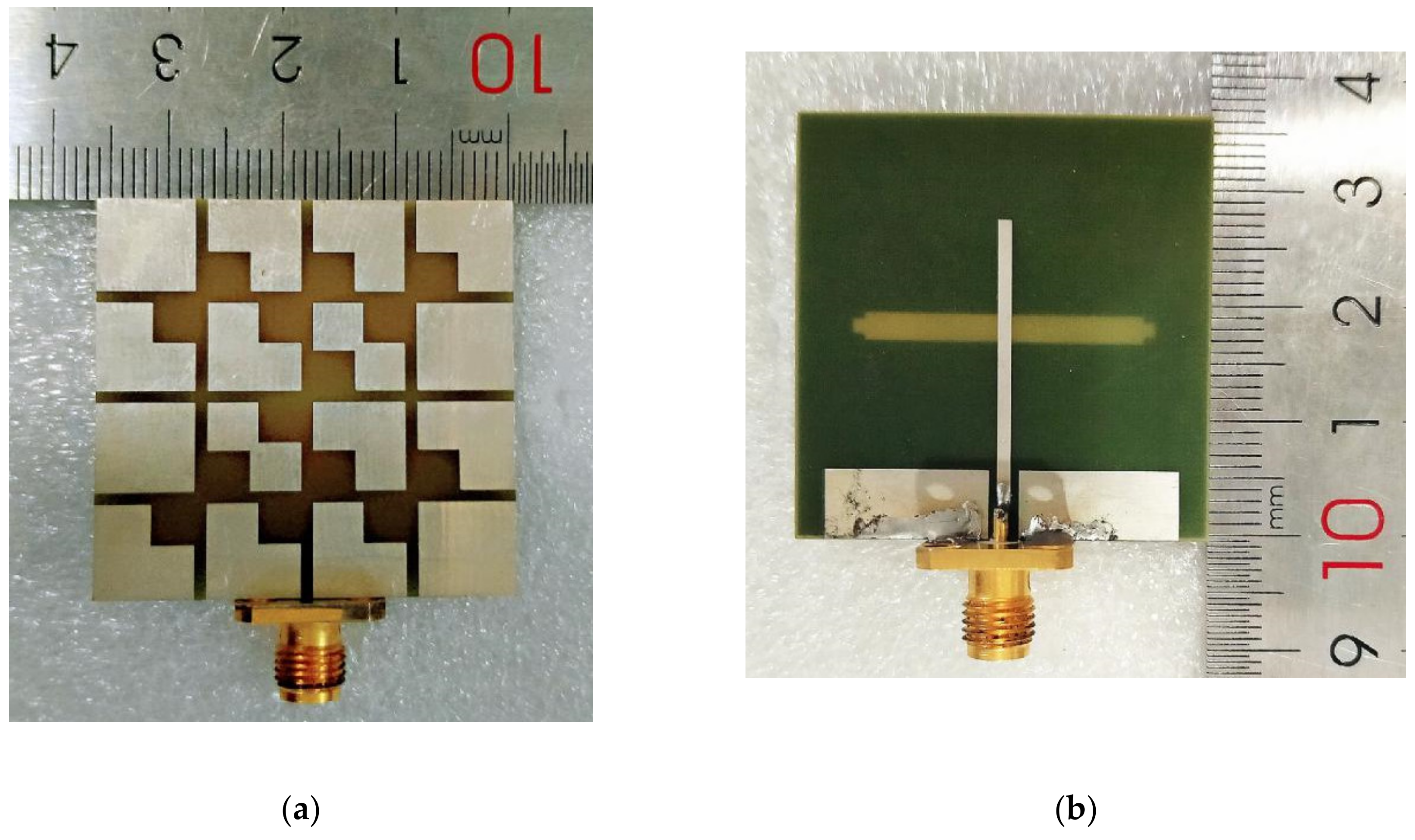
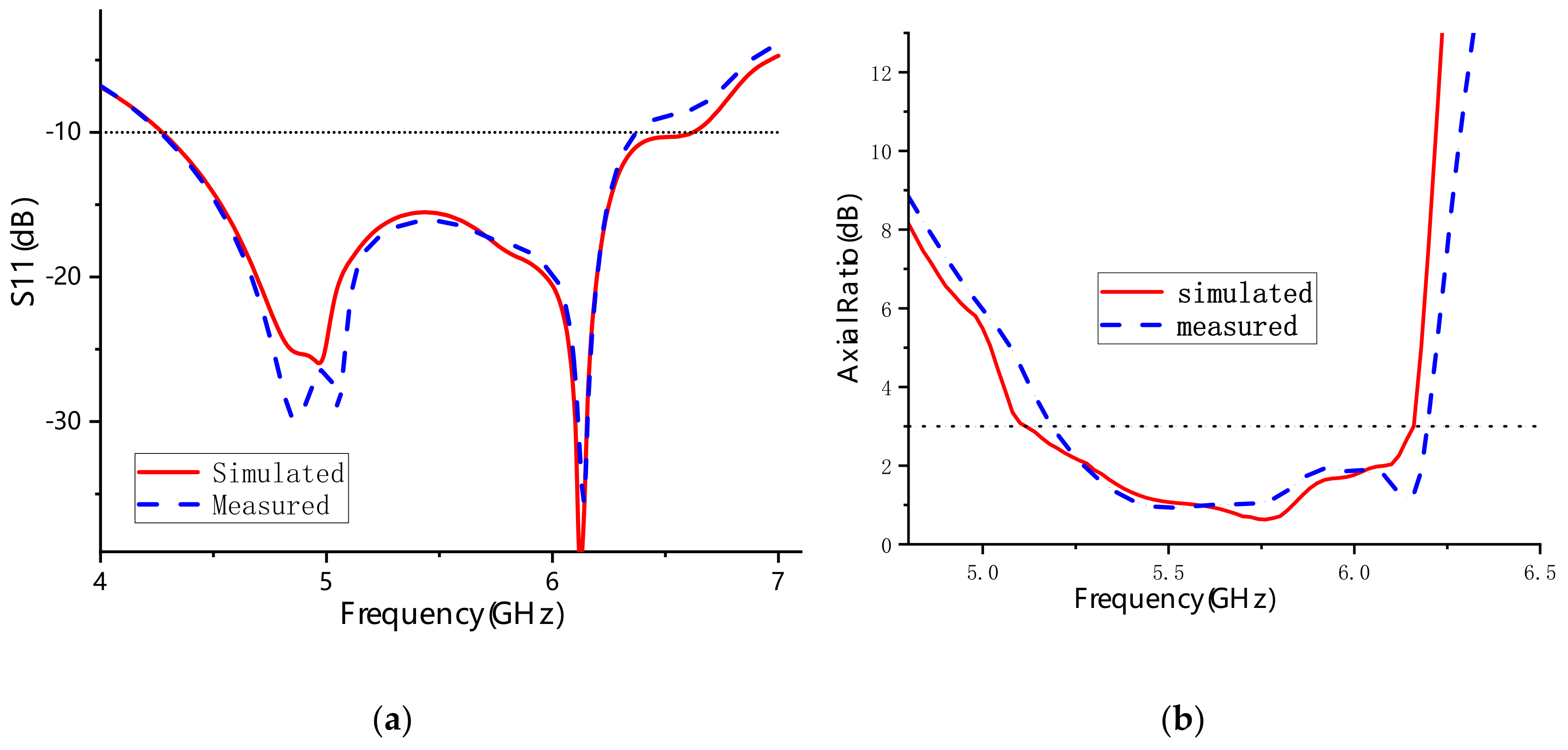
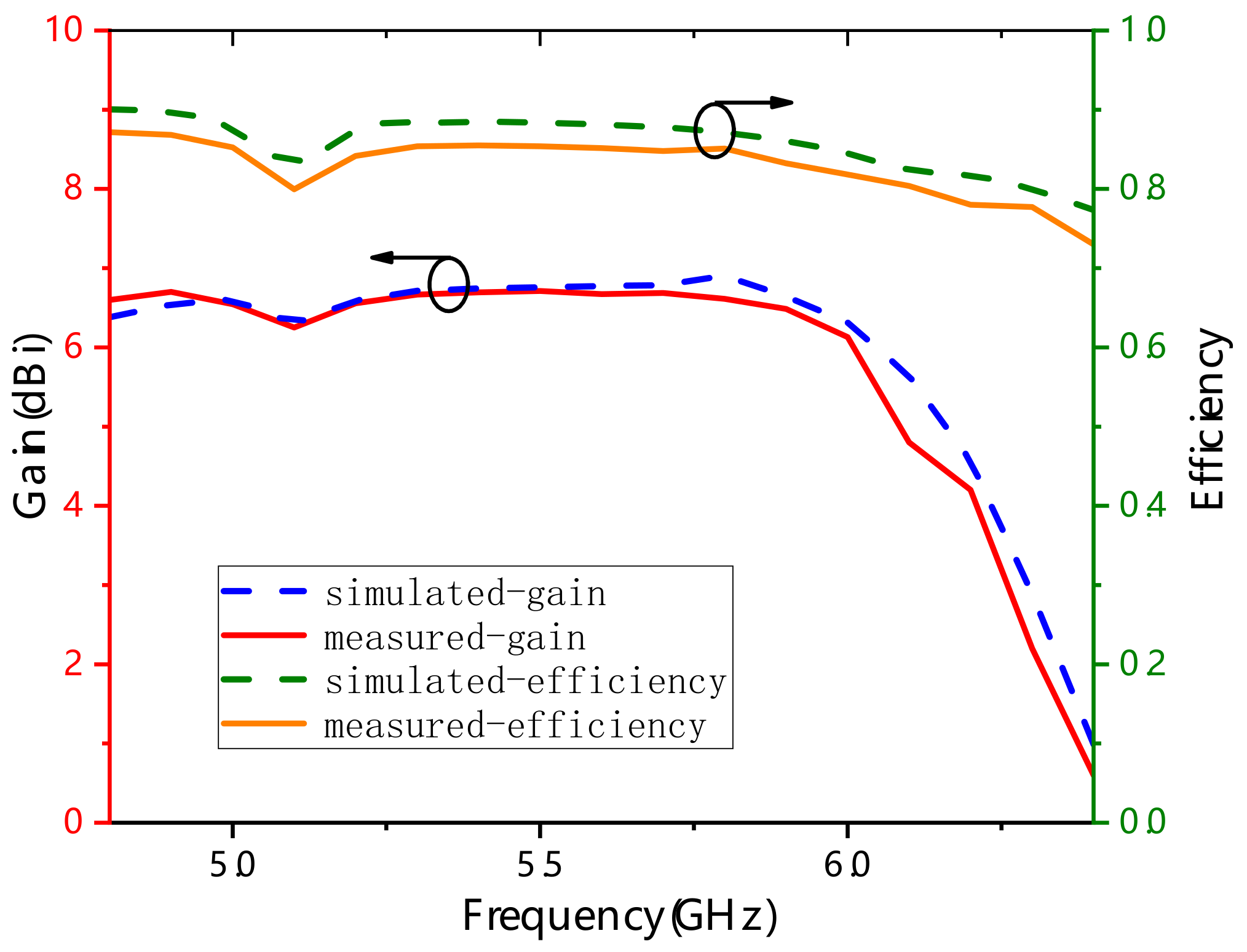

| Wm | w | a | ls | ws | lf | wf | lg | wg | p | q | gf | h1 | h0 |
|---|---|---|---|---|---|---|---|---|---|---|---|---|---|
| 36 | 1 | 3.63 | 24 | 2.2 | 7 | 1.2 | 14 | 6 | 1.1 | 1 | 0.7 | 3 | 0.5 |
| REF | Size (λ03) | fo (GHz) | −10 dB S11 BW (%) | 3 dB ARBW (%) | Remarks |
|---|---|---|---|---|---|
| Ref. [8] | 0.96 × 0.96 × 0.06 | 2.4 | 22.2 | 8.2 | large size, narrow S11 bandwidth, and narrow ARBW |
| Ref. [9] | 0.8 × 0.98 × 0.02 | 4.2 | — | 12 | large size and narrow ARBW |
| Ref. [10] | 1.87 × 1.87 × 0.6 | 7.45 | 6.87 | 6.87 | large size, narrow S11 bandwidth, and narrow ARBW |
| Ref. [11] | 0.94 × 0.94 × 0.61 | 2.2 | 11.85 | 12.04 | large size, narrow S11 bandwidth, and narrow ARBW |
| Ref. [20] | 3.14 × 3.14 × 0.1 | 11.8 | 13.8 | 6.11 | large size, narrow S11 bandwidth, and narrow ARBW |
| Ref. [5] | 0.4 × 0.4 × 0.03 | 2.49 | 17 | 7.2 | small size, narrow S11 bandwidth, and narrow ARBW |
| Ref. [7] | 0.58 × 0.58 × 0.043 | 3.5 | 23.39 | 8.5 | small size, narrow S11 bandwidth, and narrow ARBW |
| Ref. [12] | 0.61 × 0.52 × 0.05 | 4 | 16 | 10 | small size, narrow S11 bandwidth, and narrow ARBW |
| Ref. [13] | 0.36 × 0.81 × 0.035 | 3.5 | 24 | 11.4 | small size, narrow S11 bandwidth, and narrow ARBW |
| Ref. [14] | 0.6 × 0.49 × 0.07 | 5.25 | 33.7 | 16.5 | small size, narrow S11 bandwidth, and narrow ARBW |
| Ref. [15] | 0.71 × 0.71 × 0.06 | 5.5 | 33.6 | 18.2 | large size, narrow S11 bandwidth, and wide ARBW |
| Ref. [16] | 1.07 × 0.82 × 0.066 | 4.1 | 34.2 | 19.5 | large size, narrow S11 bandwidth, and wide ARBW |
| Proposed | 0.65 × 0.65 × 0.06 | 5.5 | 39.25 | 17.77 | small size, wide S11 bandwidth, and wide ARBW |
© 2020 by the authors. Licensee MDPI, Basel, Switzerland. This article is an open access article distributed under the terms and conditions of the Creative Commons Attribution (CC BY) license (http://creativecommons.org/licenses/by/4.0/).
Share and Cite
Dong, J.; Ding, C.; Mo, J. A Low-Profile Wideband Linear-to-Circular Polarization Conversion Slot Antenna Using Metasurface. Materials 2020, 13, 1164. https://doi.org/10.3390/ma13051164
Dong J, Ding C, Mo J. A Low-Profile Wideband Linear-to-Circular Polarization Conversion Slot Antenna Using Metasurface. Materials. 2020; 13(5):1164. https://doi.org/10.3390/ma13051164
Chicago/Turabian StyleDong, Jian, Chang Ding, and Jinjun Mo. 2020. "A Low-Profile Wideband Linear-to-Circular Polarization Conversion Slot Antenna Using Metasurface" Materials 13, no. 5: 1164. https://doi.org/10.3390/ma13051164
APA StyleDong, J., Ding, C., & Mo, J. (2020). A Low-Profile Wideband Linear-to-Circular Polarization Conversion Slot Antenna Using Metasurface. Materials, 13(5), 1164. https://doi.org/10.3390/ma13051164






